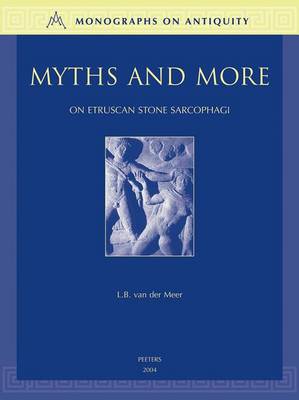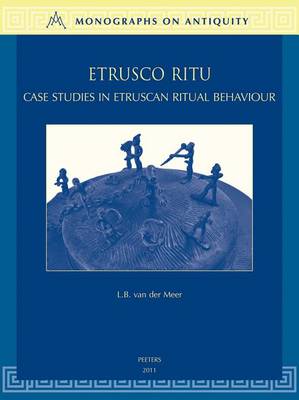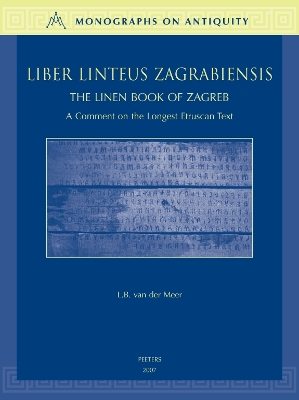Monographs on Antiquity
3 total works
v.3
"Myths and More on Etruscan Stone Sarcophagi" focuses on the chronology and meaning of representations, in painting or (painted) relief, on one hundred forty-eight coffins. After the appearance of R. Herbig's catalogue "Die jungeretruskischen Steinsarkophage" (Berlin) in 1952 many new tombs with sarcophagi were discovered. It is therefore worthwile to review Herbig's chronology and interpretations after a period of fifty years. It appears that the sarcophagi have been made over a period of around six generations, between approximately 350 and 200 BC, at a time which was crucial in the history of Etruria. Between 396 and 264 BC Rome conquered the Etruscan world. The question is: what impact did this conquest have on the minds of the Etruscan ruling elite and of the artisans, at Vulci, Cerveteri, Tarquinia and its hinterlands, at Orvieto, Chiusi and Volterra? Attention is paid to the find-spots, the family tombs, the owners of the sarcophagi, as well as to their social background and civil status. The shift in the choice of themes on the coffins showing first mythological, then Underworld and so-called decorative scenes, and the reason for iconographic changes will be discussed.
It will be explained why the choice of mythological themes is almost entirely limited to Trojan and Theban myths. Non-mythological scenes, processions and rites of passage, the Underworld, hunting and battles, including Celtomachies, will also be dealt with. The so-called heraldic schemes may have a symbolic meaning referring to Dionysiac pleasures in the Underworld. Finally, the scenes on children's sarcophagi, with a similar content, are given attention. A catalogue will list all the Etruscan stone sarcophagi with representations, providing references to the most modern publications.
It will be explained why the choice of mythological themes is almost entirely limited to Trojan and Theban myths. Non-mythological scenes, processions and rites of passage, the Underworld, hunting and battles, including Celtomachies, will also be dealt with. The so-called heraldic schemes may have a symbolic meaning referring to Dionysiac pleasures in the Underworld. Finally, the scenes on children's sarcophagi, with a similar content, are given attention. A catalogue will list all the Etruscan stone sarcophagi with representations, providing references to the most modern publications.
v.5
This book focuses on Etruscan private and public ritual behaviour in the last millennium BC. It is based on archaeological, epigraphical and historical sources. Topics are context, form, origins, agency, dynamics (homeostasis or change), meaning, function and the survival of rites in the Roman imperial and later periods. After an introduction to recent theories and definitions, first private rituals are traced, rites de passage like marriage, birth, perinatal burial, transition to adulthood, immersion, healing, adoption, divination and consecration. Mortuary rituals are dealt with separately in view of their private and public dimensions. Pre-burial, burial, and post-burial rites, are primarily analysed by paying attention to sets of grave-goods, and to artefacts and bones found in or near a tomb, as written sources are almost absent. Grave sets reflect, from c. 800 until c. 40 BC, the core activity first of the elite and later of the rich middle class, namely eating and wine drinking. Not only the deceased were supposed to continue this ritual in the netherworld, eating and drinking also took place in pre- and post-burial phases of funerals.
This practice was important for reasons of self-repesentation, consolidation of power, and social reproduction. Finally, fragments of or quotations from sacred books, especially lost libri rituales, transmitted by Greek and Roman authors, are confronted with the evidence of recent archaeological excavations, especially in newly founded cities. Though ancient authors were biased, it will appear that their information, especially on cosmological orientation, orthogonality, mundus, sulcus primigenius, and pomerium, often has a core of truth. Most Etruscan rituals disappeared in the fourth century AD. A few, however, survived until the present day, be it in a changed way, and in different contexts.
This practice was important for reasons of self-repesentation, consolidation of power, and social reproduction. Finally, fragments of or quotations from sacred books, especially lost libri rituales, transmitted by Greek and Roman authors, are confronted with the evidence of recent archaeological excavations, especially in newly founded cities. Though ancient authors were biased, it will appear that their information, especially on cosmological orientation, orthogonality, mundus, sulcus primigenius, and pomerium, often has a core of truth. Most Etruscan rituals disappeared in the fourth century AD. A few, however, survived until the present day, be it in a changed way, and in different contexts.
v.4
Liber Linteus Zagrabiensis. The Linen Book of Zagreb
by L. B. Van Der Meer
Published 31 December 2007
This book is the first complete analysis of and comment on a unique Etruscan document, the Liber linteus zagrabiensis, the linen book of Zagreb, better known as the Mummy Wrappings of Zagreb, dated to the first half of the second century BC, containing the longest Etruscan text (c. 1330 words). It was made in Etruria and later on reused in Egypt. There the book was cut into eight strips, five of which were partly preserved. The book contains twelve columns or 'pages'. C. 60% of the original text has been preserved.


